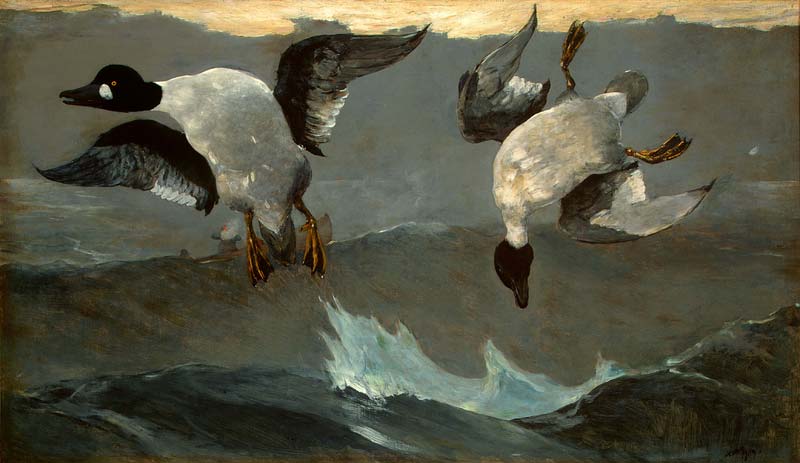| Right and Left | |
|---|---|
 |
|
| Artist | Winslow Homer |
| Year | 1909 |
| Medium | Oil on canvas |
| Location | National Gallery of Art, Washington, D.C. |
| Dimensions | 28.3 in × 48.4 in |
| 71.8 cm × 122.9 cm | |
| Famous Paintings by Winslow Homer | |
| Snap the Whip | |
| The Gulf Stream | |
| Breezing Up (A Fair Wind) | |
| Right and Left | |
| The Fox Hunt | |
| Eight Bells | |
| The Life Line | |
| The Herring Net | |
| The Blue Boat | |
| Complete Works |
Born in Boston, Massachusetts, Winslow Homer was a landscape painter, illustrator, and printmaker. His primary medium was watercolor and oil on canvas, and his best known paintings were of marine, hunting, and sporting themes. Homer was a principled artist, continuously refining his artistic skills to produce painting which were powerful in beauty and also movingly profound. His later paintings were heroic, and sometimes had mythical realism, displaying the force of nature, the wilderness and sea, and human battles with nature. Homer remains among the most admired and respected painters in American art history.
Description
Right and Left depicts two goldeneye ducks in the air, almost as if they are flying out of the picture. The ducks are captured at the moment when the duck on the right is shot by a man in a boat. The hunter is off in the distant sea, to the left, and is hardly visible. There is a red flash of paint, and gray wisps of paint surrounding the hunter’s small, brown boat. The goldeneyes are very detailed, and the duck on the right is positioned as though it is plunging to the water.
The sea is very choppy and dark gray, with waves of lighter blue, creating a turbulent atmosphere. In the detail, you can see a thin sliver of reddish-orange color, portraying a sunrise, just edging above the horizon. To the right, a single feather can be seen, floating off in the sky. The viewer feels as though he is in the air with the birds, witnessing the goldeneye’s flight of right to left. Homer’s creative and complex style of painting combines his popular hunting imagery of earlier days, with a Japanese style of painting. If the viewer is far away from the painting, the painting appears as abstract shapes, against bands of gray and off-white color.
Symbolism
Homer tried to avoid discussing the meaning of this painting, and his silence has led to a wide variety of interpretations. The most obvious interpretation of the title is that the goldeneyes are flying from right to left in the picture. Homer however, characteristically disguised personal and profound meanings in his paintings. One interpretation is that because Homer suffered a stroke in 1908, he may have been insinuating a premonition of his own mortality.
Another interpretation of Right and Left refers to the double barrels of a shotgun. The picture may be confronting the moment of the ducks’ death, by being shot, capturing the split-second event of the shot. The duck on the right has been shot, and the duck on the left will receive the second shot from the other barrel of the gun. A foreshadowing of inevitable death, the painting shows successive, but simultaneous views, creating undeniable sadness. The viewer feels the sense of confrontation and immediate sense of the bird’s extinction.
An interesting aspect of Homer’s Right and Left is that the viewer is at the bird’s perspective, but he is also in the line of fire. The hunter’s gun is pointed directly at the viewer, relaying an ambiguous message. It also portrays that no one is immune from mortality. It is unknown whether the duck on the right has been shot, or whether it is diving to safety. The underlying meaning being that even if the duck escaped, the danger remains, with a danger of mortality to all. A final interpretation is an oblique reference to modern life. In 1908, air travel was a novel achievement of man, but was also full of adventure and danger. Right and Left was Homer Winslow’s last great painting, and was completed the year before his own death.